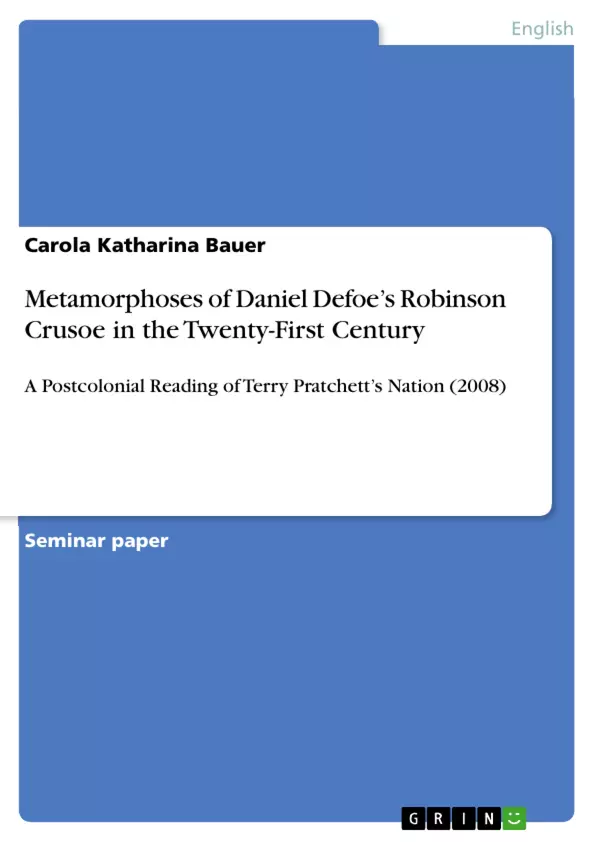"There scarce exists a work so popular as Robinson Crusoe. It is read eagerly by young people; and there is hardly an elf so devoid of imagination as not to have supposed for himself a solitary island in which he could act Robinson Crusoe, were it but in the corner of the nursery." (Ballantyne 7)
With these words, John Ballantyne reinstates Robinson Crusoe (1719) as a novel appealing to younger readers in his essay about "Daniel De Foe [sic]", published in 1810. And indeed: Although the implicit reader of the first novel in English literature was not specifically mentioned to be of young age, “children have been its principal readers throughout the [last 300] years” (Lundin 199). Thus, it is not surprising that novels also popular with a younger audience – such as Treasure Island by Robert Louis Stevenson – resemble the famous castaway narrative by repeating its main topics and motifs like the solitary island and the shipwreck (Green 143). One of the more recent adaptations of Robinson Crusoe is Terry Pratchett’s Nation, published in 2008: Taking place “on a South Sea island in a skewed version of the 19th century” (Boyce), the story centers around the cultural encounter of the shipwrecked, adolescent daughter of a British colonial governor, called Daphne, with an indigenous boy named Mau, whose whole nation was obliterated by a tsunami.
Whereas Robinson Crusoe can be clearly considered to be an imperialist and racist novel, with its protagonist becoming the “true symbol of the British conquest” – as James Joyce puts it in his essay about Daniel Defoe in 1912 (Joyce 10) – Pratchett’s book has been appraised by critics as a “novel of ideas, a ferocious questioning of vested cultural attitudes and beliefs” (Dirda), and said to reveal “the stupidity of “ignorance and prejudices [i.e. concerning race]” (Tucker). But, taking Claire Bradford’s warning into account that contemporary children’s literature dealing with cultural difference is “not necessarily free of the ideological freight of those earlier times [i.e. colonialist discourse]” (Bradford 48), my research paper will look at Terry Pratchett’s Nation in detail: With a theoretical approach based on Postcolonial Theory and Critical Whiteness Studies, this postmodern version of Daniel Defoe’s novel will be analyzed with special regard to its concepts of race, gender, and culture.
Inhaltsverzeichnis (Table of Contents)
- Robinson Crusoe Meets the Discworld: Pratchett vs. Defoe
- Daniel Defoe's Robinson Crusoe (1719) in the Light of Postcolonial Theory
- Robinson Crusoe - A 'True Symbol of British Conquest'
- Friday and the 'Savages' – Race, Religion and Slavery in Robinson Crusoe
- Terry Pratchett's Nation (2008) – ‘REWORKING THE OLD CRUSOE-MYTH’
- 'Ghost Girl' and 'Noble Savage' - Searching for Robinson and Friday
- Representing the Past: The British Empire and colonialist discourse in Pratchett's Nation
- Conclusion
Zielsetzung und Themenschwerpunkte (Objectives and Key Themes)
The purpose of this paper is to analyze Terry Pratchett's novel Nation, focusing on its relationship to Daniel Defoe's Robinson Crusoe. It aims to uncover how Nation, set in a postcolonial context, critiques the colonialist discourse present in Robinson Crusoe. This analysis will be done through the lens of Postcolonial Theory and Critical Whiteness Studies, examining how Pratchett's novel presents themes of race, gender, and culture.
- The impact of colonialist discourse on both Robinson Crusoe and Nation
- The role of race and colonialism in shaping the narratives of both novels
- The representation of indigenous cultures in Nation and its comparison to Robinson Crusoe
- The influence of gender dynamics in the context of colonialism
- The potential for Nation to be a critique of Robinson Crusoe's colonialist themes
Zusammenfassung der Kapitel (Chapter Summaries)
Chapter 1 delves into the enduring popularity of Robinson Crusoe, especially among young readers. It explores how Nation, Pratchett's contemporary adaptation of the classic castaway narrative, offers a unique perspective on colonialism and cultural encounters. The chapter introduces key themes of colonialism, race, and gender that will be explored throughout the paper.
Chapter 2 examines Robinson Crusoe through the lens of Postcolonial Theory, analyzing the novel's inherent imperialist themes. It highlights how the protagonist, Robinson Crusoe, embodies the archetype of the British colonizer, highlighting his possessive attitude towards the island, his exploitative treatment of nature and indigenous peoples, and his religious justifications for colonial domination.
Chapter 3 focuses on Nation, exploring how Pratchett reimagines the "Crusoe myth" in a postcolonial context. The chapter analyzes the characters of Daphne and Mau, drawing parallels and contrasts to Robinson and Friday, respectively. It explores how Nation engages with the legacy of colonialism, challenging colonialist discourse and highlighting the complexities of cultural encounters.
Schlüsselwörter (Keywords)
The key terms and concepts that form the core of this study include Postcolonial Theory, Critical Whiteness Studies, Robinson Crusoe, Nation, colonialism, race, gender, culture, indigenous peoples, cultural encounter, and literary critique.
- Citar trabajo
- Carola Katharina Bauer (Autor), 2010, Metamorphoses of Daniel Defoe’s Robinson Crusoe in the Twenty-First Century, Múnich, GRIN Verlag, https://www.grin.com/document/193476



